
SIDNEY — A presentation of the 2018 Consumer Confidence Report (CCR) revealed no violations of the Safe Drinking Water Act standards at Tuesday evening’s Sidney City Council workshop session.
Utilities Director William Blakely presented council with the CCR that ensures safe drinking water. His report contained information on the city’s water source, treatment and treatment programs, water plant staffing, definitions of terms, as well as conservation tips and city contact information.
Blakely said Sidney performed all of the required analytic tests on the drinking water and all of the contaminants required to be monitored showed no violations of the Safe Drinking Water Act standards, which was federally enacted in 1998.
He said the water treatment plant (WTP) conducts over 150,000 wet chemistry tests and over 1,800 microbiological tests per year on the city’s water. Sidney also assists in conducting tests for other water systems in the area, he said.
“We have again, as in the past, have no violations and never exceeded any maximum contaminant levels,” Blakely said.
The WTP is staffed 24/7, every day of the year, by a total of nine employees, Blakely noted. All full-time employees are licensed and certified by the Ohio Environmental Protection Agency (EPA).
Blakely pointed out the report contains educational language on common health-related contaminants and specified for council the three most well known contaminants, and the symptoms of these contaminants and precautions and treatment directives.
Any water, even bottled water, is going to have certain amount of contaminate in it, Blakely said. But anything not considered pure water, such as even calcium, for example, can be considered a contaminant, he noted.
“Some of the mandatory information that can be found in the CCR is what our source water is. Of course we have now surface water, ground water and the other (ground) water under the influence; those are the three basic categories,” he said. “Sidney’s sources are the Great Miami River, Tawawa Creek, our four bedrock wells along the river and Washington Township.”
The CCR, Blakely said, must be delivered to residents by July 1 and that a direct link will also be posted on the city’s website at www.sidneyoh.com. Residents can receive a hard copy of the report by calling Blakely at 937-498-8152. He said information about where to find the report or how to obtain a copy will be printed on residents’ water bill.
The city’s website also contains a flood action plan and monitors flood levels and projections, and additional news and information about Sidney. Blakely encouraged public participation in decisions concerning Sidney’s drinking water during the first, second and fourth Monday Sidney City Council meeting of the month at 6:30 p.m. in Council Chambers at City Hall at 201 W. Poplar St.
Blakely also introduced council members to the Ronald E. Fauls, Sidney’s new water treatment plant superintendent. Fauls joined the city of Sidney on March 25. He previously served the city of Fostoria as the water treatment plant superintendent since 2001. Blakely told council Fauls holds an Ohio EPA class IV water certification, and microbiological and chemistry full lab certifications.
Fauls thanked City Council and Blakely for the opportunity and said he was looking forward to working together.
In other business, Wastewater Superintendent Barry Zerkle led a discussion on the Wastewater Treatment Plant (WWTP) surcharge rates. He told council surcharge rates are recalculated every other year, and 2019 is the year for reevaluation of industrial users’ “excessive loadings.” Excessive loads are city sanitary sewer system wastes that exceeds normal domestic waste standards; these industry customers pay an additional surcharge to cover the costs of handling the higher wastes.
The current surcharge for total suspended solids (TSS) is $0.60 per pound of TSS and chemical oxygen demand (COD) is $0.214 per pound of COD. The current TSS unit cost formula is the previous two year annual cost average times 30 percent divided by the previous five year TSS loading at the WWTP. The current COD unit cost formula is the previous two year annual cost average times 32.2 percent divided by the previous five year COD loading at the WWTP.
The rates for years 2019-2021 for TSS/lb will decrease to $0.552 and for COD/lb will decrease to $0.188. The fluctuating rate changes over the years is due to large capital projects, Zerkle said. He was directed to bring back to council an ordinance for a first reading of the new rates.


